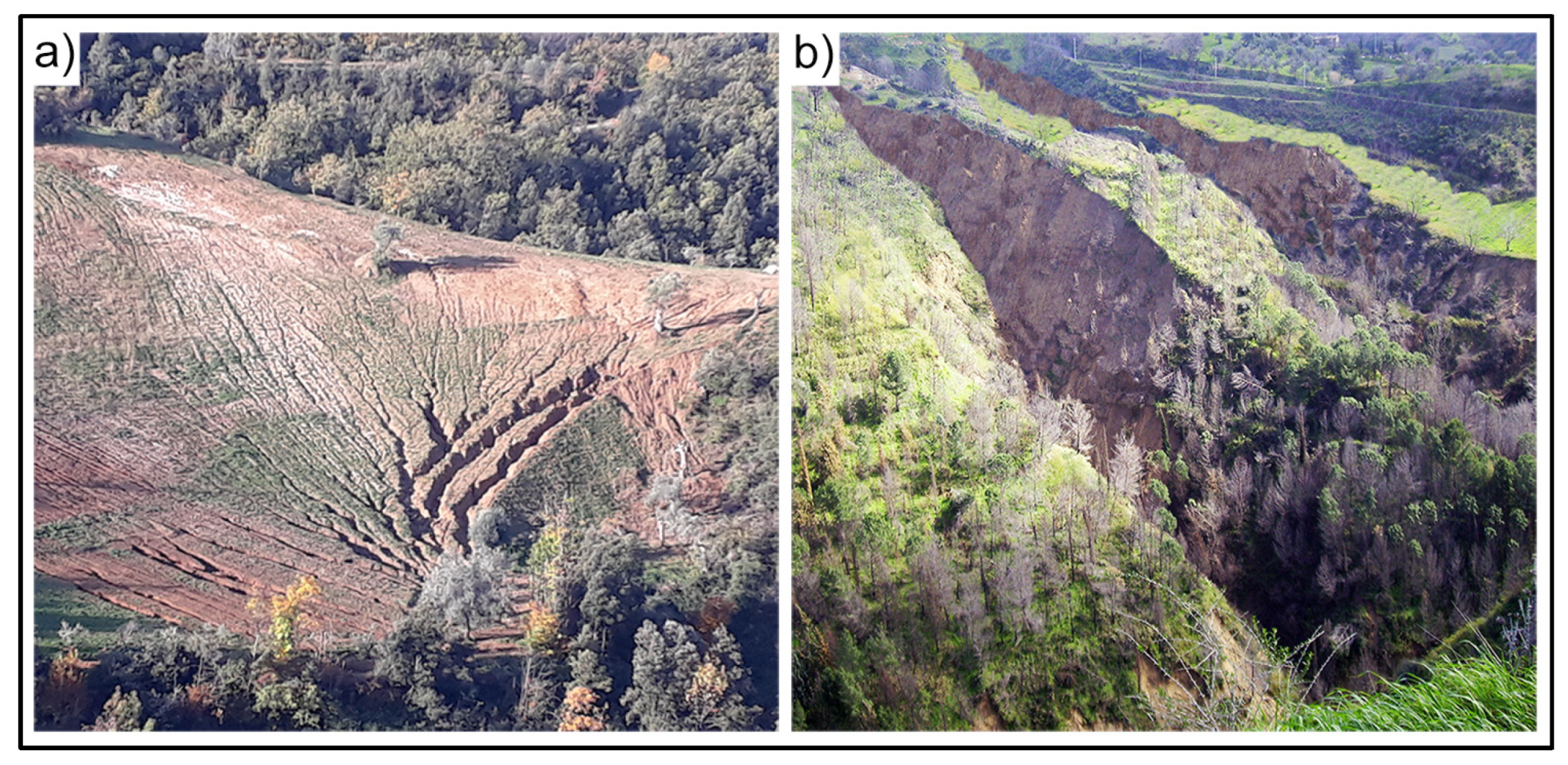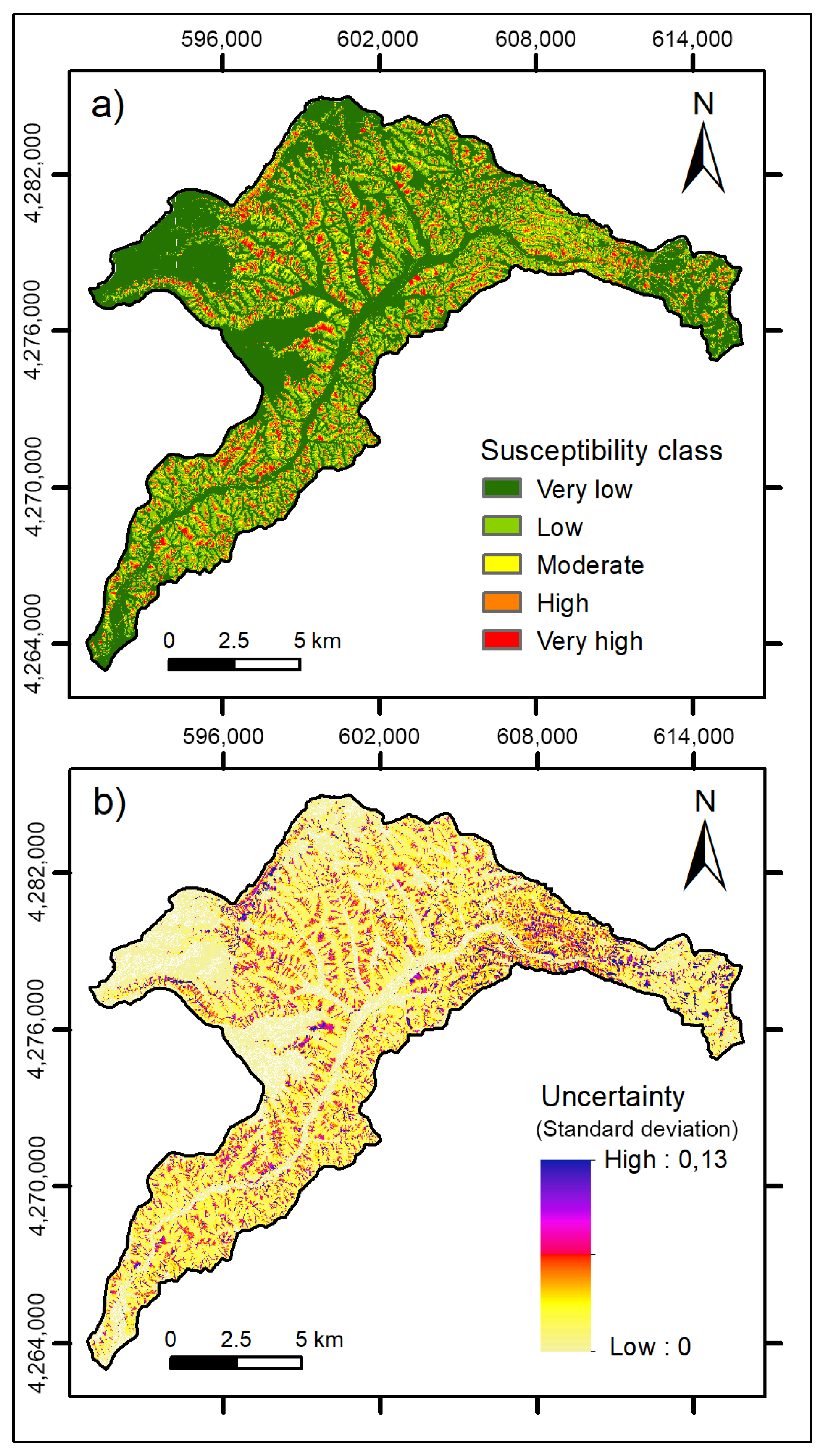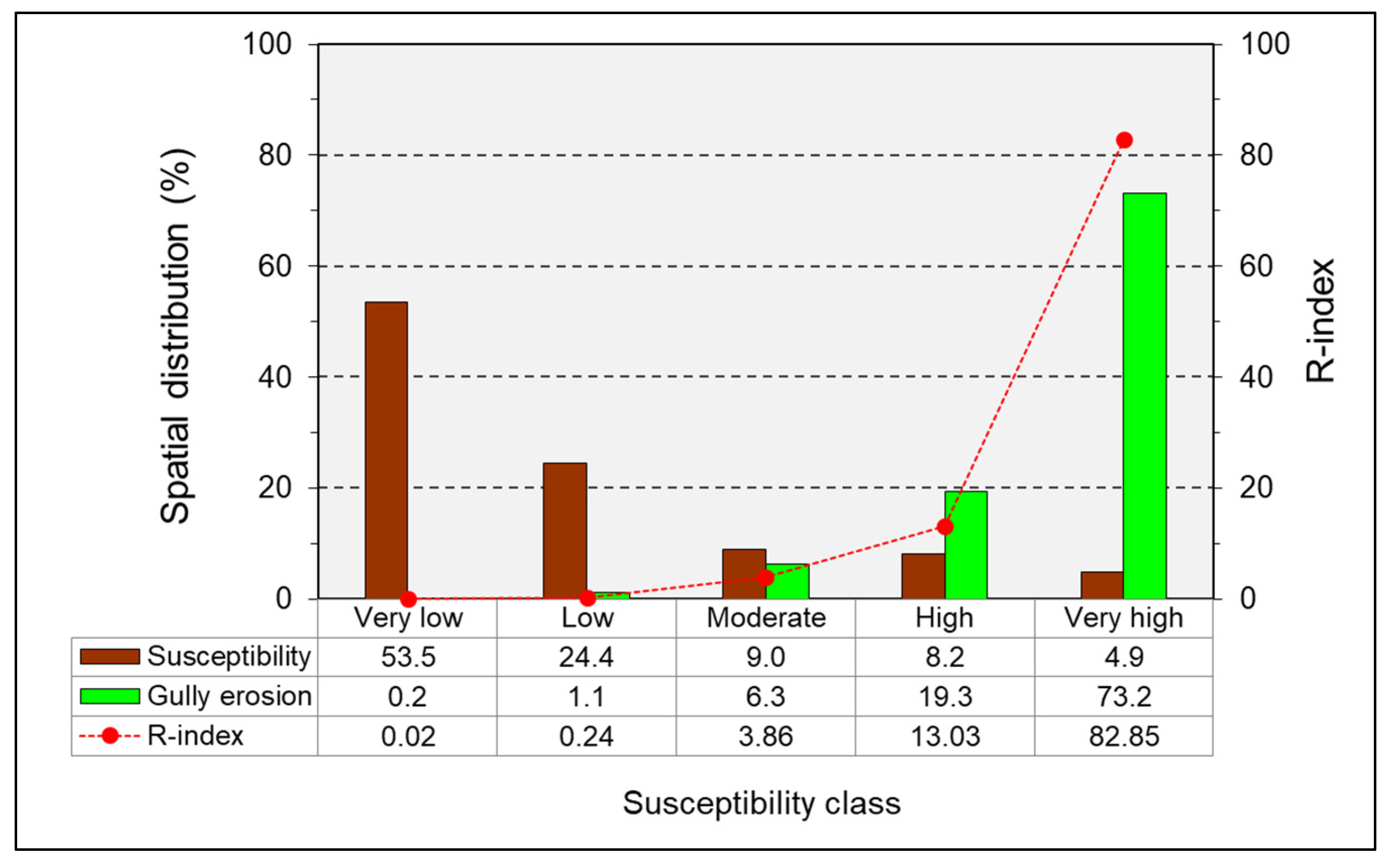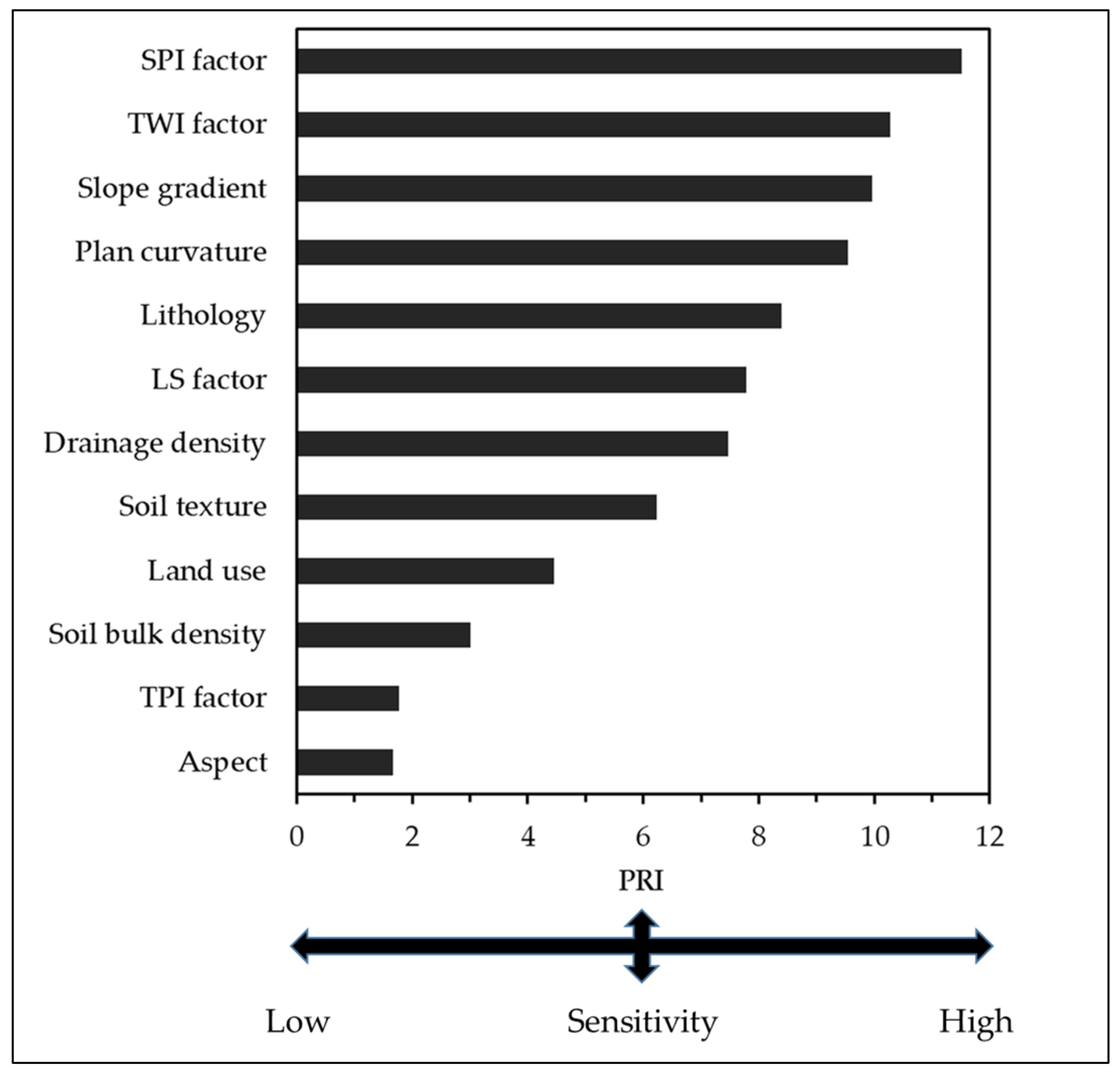Testing the Reliability of Maximum Entropy Method for Mapping Gully Erosion Susceptibility in a Stream Catchment of Calabria Region (South Italy)
Abstract
:1. Introduction
2. Study Area
3. Data Collection and Elaboration
3.1. Gully Erosion Inventory
3.2. Gully Erosion Predisposing Factors
4. Methodology
4.1. Multi-Collinearity Test
4.2. Maximum Entropy Method
4.3. Implementing Gully Erosion Susceptibility Model
4.4. Detecting Predisposing Factors’ Sensitivity
5. Results
5.1. Multi-Collinearity Analysis
5.2. Modelling Gully Erosion Susceptibility
5.3. Gully Erosion Susceptibility Map
5.4. Sensitivity Analysis of Predisposing Factors
6. Discussion
7. Conclusions
Author Contributions
Funding
Institutional Review Board Statement
Informed Consent Statement
Data Availability Statement
Conflicts of Interest
References
- Valentin, C.; Poesen, J.; Li, Y. Gully erosion: Impacts, factors and control. Catena 2005, 63, 132–153. [Google Scholar] [CrossRef]
- Kakembo, V.; Xanga, W.W.; Rowntree, K. Topographic thresholds in gully development on the hillslopes of communal areas in Ngqushwa Local Municipality, Eastern Cape, South Africa. Geomorphology 2009, 110, 188–194. [Google Scholar] [CrossRef]
- Vanmaercke, M.; Panagos, P.; Vanwalleghem, T.; Hayas, A.; Foerster, S.; Borrelli, P.; Rossi, M.; Torri, D.; Casali, J.; Borselli, L.; et al. Measuring, modelling and managing gully erosion at large scales: A state of the art. Earth Sci. Rev. 2021, 218, 103637. [Google Scholar] [CrossRef]
- Haddadchi, A.; Nosrati, K.; Ahmadi, F. Differences between the source contribution of bed material and suspended sediments in a mountainous agricultural catchment of western Iran. Catena 2014, 116, 105–113. [Google Scholar] [CrossRef]
- Chen, H.; Liu, G.; Zhang, X.C.; Shi, H.Q.; Li, H.R. Quantifying sediment source contributions in an agricultural catchment with ephemeral and classic gullies using 137Cs technique. Geoderma 2021, 398, 115112. [Google Scholar] [CrossRef]
- Farias Amorim, F.; da Silva, Y.J.A.B.; Cabral Nascimento, R.; da Silva, Y.J.A.B.; Tiecher, T.; do Nascimento, C.W.A.; Gomes Minella, J.P.; Zhang, Y.; Ram Upadhayay, H.; Pulley, S.; et al. Sediment source apportionment using optical property composite signatures in a rural catchment, Brazil. Catena 2021, 202, 105208. [Google Scholar] [CrossRef]
- Lal, R. Soil degradation by erosion. Land Degrad. Dev. 2001, 12, 519–539. [Google Scholar] [CrossRef]
- Poesen, J.; Nachtergaele, J.; Verstraeten, G.; Valentin, C. Gully erosion and environmental change: Importance and research needs. Catena 2003, 50, 91–133. [Google Scholar] [CrossRef]
- Amundson, R.; Berhe, A.A.; Hopmans, J.W.; Olson, C.; Sztein, A.E.; Sparks, D.L. Soil and human security in the 21st century. Science 2015, 348, 1261071. [Google Scholar] [CrossRef]
- Borrelli, P.; Poesen, J.; Vanmaercke, M.; Ballabio, C.; Hervàs, J.; Maerker, M.; Scarpa, S.; Panagos, P. Monitoring gully erosion in the European Union: A novel approach based on the Land Use/Cover Area frame survey (LUCAS). Int. Soil Water Conserv. Res. 2022, 10, 17–28. [Google Scholar] [CrossRef]
- Vandekerckhove, L.; Poesen, J.; Oostwoudwijdenes, D.J.; Gyssels, G.; Beuselinck, L.; De Luna, E. Characteristics and controlling factors of bank gullies in two semiarid Mediterranean environments. Geomorphology 2000, 33, 37–58. [Google Scholar] [CrossRef]
- Conforti, M.; Pascale, S.; Pepe, M.; Sdao, F.; Sole, A. Denudation processes and landforms map of the Camastra River catchment (Basilicata—South Italy). J. Maps 2013, 9, 444–445. [Google Scholar] [CrossRef]
- Conoscenti, C.; Angileri, S.; Cappadonia, C.; Rotigliano, E.; Agnesi, V.; Märker, M. Geomorphology Gully erosion susceptibility assessment by means of GIS-based logistic regression: A case of Sicily (Italy). Geomorphology 2014, 204, 399–411. [Google Scholar] [CrossRef]
- Deng, Q.; Qin, F.; Zhang, B.; Wang, H.; Luo, M.; Shu, C.; Liu, H.; Liu, G. Characterizing the morphology of gully cross-sections based on PCA: A case of Yuanmou Dry-Hot Valley. Geomorphology 2015, 228, 703–713. [Google Scholar] [CrossRef]
- Borrelli, L.; Conforti, M.; Mercuri, M. Lidar and UAV system data to analyse recent morphological changes of a small drainage basin. ISPRS Int. J. Geoinf. 2019, 8, 536. [Google Scholar] [CrossRef]
- Pulice, I.; Scarciglia, F.; Leonardi, L.; Robustelli, G.; Conforti, M.; Cuscino, M.; Lupiano, V.; Critelli, S. Studio Multidisciplinare di Forme e Processi Denudazionali nell’area di Vrica (Calabria Orientale). Mem. Soc. Geogr. Italy 2009, 87, 403–417. [Google Scholar]
- Terranova, O.; Antronico, L.; Coscarelli, R.; Iaquinta, P. Soil erosion risk scenarios in the Mediterranean environment using RUSLE and GIS: An application model for Calabria (Southern Italy). Geomorphology 2009, 112, 228–245. [Google Scholar] [CrossRef]
- Conforti, M.; Buttafuoco, G.; Rago, V.; Aucelli, P.P.C.; Robustelli, G.; Scarciglia, F. Soil loss assessment in the Turbolo catchment (Calabria, Italy). J. Maps 2016, 12, 815–825. [Google Scholar] [CrossRef]
- Amare, S.; Langendoen, E.; Keesstra, S.; Ploeg, M.V.D.; Gelagay, H.; Lemma, H.; Van Der Zee, S.E. Susceptibility to gully erosion: Applying random forest (RF) and frequency ratio (FR) approaches to a small catchment in Ethiopia. Water 2021, 13, 216. [Google Scholar] [CrossRef]
- Rahmati, O.; Tahmasebipour, N.; Haghizadeh, A.; Pourghasemi, H.R.; Feizizadeh, B. Evaluating the influence of geo-environmental factors on gully erosion in a semi-arid region of Iran: An integrated framework. Sci. Total Environ. 2017, 579, 913–927. [Google Scholar] [CrossRef]
- Arabameri, A.; Pradhan, B.; Pourghasemi, H.R.; Rezaei, K.; Kerle, N. Spatial modelling of gully erosion using GIS and R programing: A comparison among three data mining algorithms. Appl. Sci. 2018, 8, 1369. [Google Scholar] [CrossRef]
- Garosi, Y.; Sheklabadi, M.; Pourghasemi, H.R.; Besalatpour, A.A.; Conoscenti, C.; Van Oost, K. Comparison of differences in resolution and sources of controlling factors for gully erosion susceptibility mapping. Geoderma 2018, 330, 65–78. [Google Scholar] [CrossRef]
- Lana, J.C.; Castro, P.D.T.A.; Lana, C.E. Assessing gully erosion susceptibility and its conditioning factors in southeastern Brazil using machine learning algorithms and bivariate statistical methods: A regional approach. Geomorphology 2022, 402, 108159. [Google Scholar] [CrossRef]
- Rahmati, O.; Kalantari, Z.; Ferreira, C.S.; Chen, W.; Soleimanpou, S.M.; Kapović-Solomun, M.; Seifollahi-Aghmiuni, S.; Ghajarnia, N.; Kazemabady, N.K. Contribution of physical and anthropogenic factors to gully erosion initiation. Catena 2022, 210, 105925. [Google Scholar] [CrossRef]
- Bouramtane, T.; Hilal, H.; Rezende-Filho, A.T.; Bouramtane, K.; Barbiero, L.; Abraham, S.; Valles, V.; Kacimi, I.; Sanhaji, H.; Torres-Rondon, L.; et al. Mapping gully erosion variability and susceptibility using remote sensing, multivariate statistical analysis, and machine learning in South Mato Grosso, Brazil. Geosciences 2022, 12, 235. [Google Scholar] [CrossRef]
- Garosi, Y.; Sheklabadi, M.; Conoscenti, C.; Pourghasemi, H.R.; Van Oost, K. Assessing the performance of GIS- based machine learning models with different accuracy measures for determining susceptibility to gully erosion. Sci. Total Environ. 2019, 664, 1117–1132. [Google Scholar] [CrossRef] [PubMed]
- Rahmati, O.; Haghizadeh, A.; Pourghasemi, H.R.; Noormohamadi, F. Gully erosion susceptibility mapping: The role of GIS-based bivariate statistical models and their comparison. Nat. Hazards 2016, 82, 1231–1258. [Google Scholar] [CrossRef]
- Al-Abadi, A.M.; Al-Ali, A.K. Susceptibility mapping of gully erosion using GIS-based statistical bivariate models: A case study from Ali Al-Gharbi District, Maysan Governorate, southern Iraq. Environ. Earth Sci. 2018, 77, 249. [Google Scholar] [CrossRef]
- Azareh, A.; Rahmati, O.; Rafiei-Sardooi, E.; Sankey, J.B.; Lee, S.; Shahabi, H.; Ahmad, B. Bin Modelling gully-erosion susceptibility in a semi-arid region, Iran: Investigation of applicability of certainty factor and maximum entropy models. Sci. Total Environ. 2019, 655, 684–696. [Google Scholar] [CrossRef]
- Dube, F.; Nhapi, I.; Murwira, A.; Gumindoga, W.; Goldin, J.; Mashauri, D.A. Potential of weight of evidence modelling for gully erosion hazard assessment in Mbire District–Zimbabwe. Phys. Chem. Earth 2014, 67–69, 145–152. [Google Scholar] [CrossRef]
- Arabameri, A.; Pradhan, B.; Rezaei, K. Gully erosion zonation mapping using integrated geographically weighted regression with certainty factor and random forest models in GIS. J. Environ. Manag. 2019, 232, 928–942. [Google Scholar] [CrossRef] [PubMed]
- Arabameri, A.; Yamani, M.; Pradhan, B.; Melesse, A.; Shirani, K.; Tien Bui, D. Novel ensembles of COPRAS multi-criteria decision-making with logistic regression, boosted regression tree, and random forest for spatial prediction of gully erosion susceptibility. Sci. Total Environ. 2019, 688, 903–916. [Google Scholar] [CrossRef] [PubMed]
- Pourghasemi, H.R.; Yousefi, S.; Kornejady, A.; Cerdà, A. Performance assessment of individual and ensemble data-mining techniques for gully erosion modeling. Sci. Total Environ. 2017, 609, 764–775. [Google Scholar] [CrossRef] [PubMed]
- Chuma, G.B.; Mugumaarhahama, Y.; Mond, J.M.; Bagula, E.M.; Ndeko, A.B.; Lucungu, P.B.; Karume, K.; Mushagalusa, G.N.; Schmitz, S. Gully erosion susceptibility mapping using four machine learning methods in Luzinzi watershed, eastern Democratic Republic of Congo. Phys. Chem. Earth Parts A B C 2023, 129, 103295. [Google Scholar] [CrossRef]
- Saha, S.; Roy, J.; Arabameri, A.; Blaschke, T.; Bui, D.T. Machine learning-based gully erosion susceptibility mapping: A case study of eastern India. Sensors 2020, 20, 1313. [Google Scholar] [CrossRef] [PubMed]
- Conforti, M.; Ietto, F. Influence of tectonics and morphometric features on the landslide distribution: A case study from the Mesima basin (Calabria, south Italy). J. Earth Sci. 2020, 31, 393–409. [Google Scholar] [CrossRef]
- Tortorici, G.; Bianca, M.; De Guidi, G.; Monaco, C.; Tortorici, L. 2003 Fault activity and marine terracing in the Capo Vaticano area (southern Calabria) during the middle–late Quaternary. Quat. Int. 2003, 101–102, 269–278. [Google Scholar] [CrossRef]
- Brutto, F.; Muto, F.; Loreto, M.F.; De Paola, N.; Tripodi, V.; Critelli, S.; Facchin, L. The Neogene-Quaternary geodynamic evolution of the central Calabrian Arc: A case study from the western Catanzaro Trough basin. J. Geodyn. 2016, 102, 95–114. [Google Scholar] [CrossRef]
- Perri, F.; Ietto, F.; Le Pera, E.; Apollaro, C. Weathering processes affecting granitoid profiles of Capo Vaticano (Calabria, southern Italy) based on petrographic, mineralogic and reaction path modelling approaches. Geol. J. 2016, 51, 368–386. [Google Scholar] [CrossRef]
- Apollaro, C.; Perri, F.; Le Pera, E.; Fuoco, I.; Critelli, T. Chemical and minero-petrographical changes on granulite rocks affected by weathering processes. Front. Earth Sci. 2019, 13, 247–261. [Google Scholar] [CrossRef]
- Ietto, F.; Le Pera, E.; Perri, F. Weathering of the ‘Rupe di Tropea’ (southern Calabria): Consolidation criteria and erosion-rate estimate. Rend. Online Soc. Geol. Ital. 2013, 24, 178–180. [Google Scholar]
- Conforti, M.; Ietto, F. Modeling shallow landslide susceptibility and assessment of the relative importance of predisposing factors, through a GIS-based statistical analysis. Geosciences 2021, 11, 333. [Google Scholar] [CrossRef]
- USDA. Keys to soil taxonomy. In Soil Survey Staff, 12th ed.; USDA, Natural Resources Conservation Service: Washington, DC, USA, 2014; p. 372. [Google Scholar]
- ARSSA. Carta dei suoli della regione Calabria—Scala 1:250000. In Monografia Divulgativa; Servizio Agropedologia; ARSSA—Agenzia Regionale per lo Sviluppo e per i Servizi in Agricoltura, Rubbettino Publisher: Soveria Mannelli, Italy, 2003; 387p. [Google Scholar]
- Conforti, M.; Longobucco, T.; Scarciglia, F.; Niceforo, G.; Matteucci, G.; Buttafuoco, G. Interplay between Soil Formation and Geomorphic Processes along a Soil Catena in a Mediterranean Mountain Landscape: An Integrated Pedological and Geophysical Approach. Environ. Earth Sci. 2020, 79, 59. [Google Scholar] [CrossRef]
- Mararakanye, N.; Sumner, P.D. Gully erosion: A comparison of contributing factors in two catchments in South Africa. Geomorphology 2017, 288, 99–110. [Google Scholar] [CrossRef]
- Amiri, M.; Pourghasemi, H.R.; Ghanbarian, G.A.; Afzali, S.F. Assessment of the importance of gully erosion effective factors using Boruta algorithm and its spatial modeling and mapping using three machine learning algorithms. Geoderma 2019, 340, 55–69. [Google Scholar] [CrossRef]
- Chowdhuri, I.; Pal, S.C.; Arabameri, A.; Saha, A.; Chakrabortty, R.; Blaschke, T.; Pradhan, B.; Band, S.S. Implementation of Artificial Intelligence Based Ensemble Models for Gully Erosion Susceptibility Assessment. Remote Sens. 2020, 12, 3620. [Google Scholar] [CrossRef]
- Olaya, V.A. Gentle Introduction to SAGA GIS. In The SAGA User Group eV; SAGA: Göettingen, Germany, 2004. [Google Scholar]
- Arora, A.; Pandey, M.; Siddiqui, M.A.; Hong, H.; Mishra, V.N. Spatial Flood Susceptibility Prediction in Middle Ganga Plain: Comparison of Frequency Ratio and Shannon’s Entropy Models. Geocarto Int. 2019, 36, 2085–2116. [Google Scholar] [CrossRef]
- Alin, A. Multicollinearity. Wiley Interdiscip. Rev. Comput. Stat. 2010, 2, 370–374. [Google Scholar] [CrossRef]
- Javidan, N.; Kavian, A.; Pourghasemi, H.R.; Conoscenti, C.; Jafarian, Z.; Rodrigo-Comino, J. Evaluation of multi-hazard map produced using MaxEnt machine learning technique. Sci. Rep. 2021, 11, 6496. [Google Scholar] [CrossRef]
- Dormann, C.F.; Elith, J.; Bacher, S.; Buchmann, C.; Carl, G.; Carre, G.; Marquez, J.R.G.; Gruber, B.; Lafourcade, B.; Leitao, P.J.; et al. Collinearity: A review of methods to deal with it and a simulation study evaluating their performance. Ecography 2013, 36, 27–46. [Google Scholar] [CrossRef]
- Phillips, S.J.; Robert, P.; Andersonb, C.; Schapired, R.E. Maximum entropy modeling of species geographic distributions. Ecol. Modell. 2006, 6, 231–259. [Google Scholar] [CrossRef]
- Woodbury, A.; Render, F.; Ulrych, T. Practical probabilistic ground-water modeling. Ground Water 1995, 33, 532–539. [Google Scholar] [CrossRef]
- Warren, D.L.; Seifert, S.N. Ecological Niche Modeling in Maxent: The Importance of Model Complexity and the Performance of Model Selection Criteria. Ecol. Appl. 2011, 21, 335–342. [Google Scholar] [CrossRef] [PubMed]
- Weber, T.C. Maximum Entropy Modeling of Mature Hardwood Forest Distribution in four U.S. States. For. Ecol. Manag. 2011, 261, 779–788. [Google Scholar] [CrossRef]
- Convertino, M.; Troccoli, A.; Catani, F. Detecting fingerprints of landslide drivers: A MaxEnt model: Fingerprints of landslide drivers. J. Geophys. Res. Earth Surf. 2013, 118, 1367–1386. [Google Scholar] [CrossRef]
- Kornejady, A.; Ownegh, M.; Bahremand, A. Landslide susceptibility assessment using maximum entropy model with two different data sampling methods. Catena 2017, 152, 144–162. [Google Scholar] [CrossRef]
- Conforti, M.; Borrelli, L.; Cofone, G.; Gullà, G. Exploring performance and robustness of shallow landslide susceptibility modeling at regional scale using different training and testing sets. Environ. Earth Sci. 2023, 82, 161. [Google Scholar] [CrossRef]
- Maerker, M.; Bosino, A.; Scopesi, C.; Giordani, P.; Firpo, M. Geoderma Assessment of calanchi and rill-interrill erosion susceptibility in northern Liguria, Italy: A case study using a probabilistic modelling framework. Geoderma 2020, 371, 114367. [Google Scholar] [CrossRef]
- Bernini, A.; Bosino, A.; Botha, G.A.; Maerker, M. Evaluation of gully erosion susceptibility using a maximum entropy model in the upper Mkhomazi River basin in South Africa. ISPRS Int. J. Geo. Inf. 2021, 10, 729. [Google Scholar] [CrossRef]
- Phillips, S.J.; Dudik, M. Modeling of species distributions with Maxent: New extensions and a comprehensive evaluation. Ecography 2008, 31, 161–175. [Google Scholar] [CrossRef]
- Sun, D.; Xu, J.; Wen, H.; Wang, Y. An optimized random forest model and its generalization ability in landslide susceptibility mapping: Application in two areas of Three Gorges Reservoir, China. J. Earth Sci. 2020, 31, 1068–1086. [Google Scholar] [CrossRef]
- Rodríguez, J.D.; Pérez, A.; Lozano, J.A. Sensitivity analysis of k-fold cross validation in prediction error estimation. IEEE Trans. Pattern Anal. Mach. Intell. 2010, 32, 569–575. [Google Scholar] [CrossRef] [PubMed]
- Fawcett, T. An introduction to ROC analysis. Pattern Recognit. Lett. 2006, 27, 861–874. [Google Scholar] [CrossRef]
- Williams, G. Data Mining with Rattle and R: The Art of Excavating Data for Knowledge Discovery; Springer: New York, NY, USA, 2011; p. 382. [Google Scholar]
- Allouche, O.; Tsoar, A.; Kadmon, R. Assessing the accuracy of species distribution models: Prevalence, kappa and the true skill statistic (TSS). J. Appl. Ecol. 2006, 43, 1223–1232. [Google Scholar] [CrossRef]
- Landis, J.R.; Koch, G.G. The measurement of observer agreement for categorical data. Biometrics 1977, 33, 159–174. [Google Scholar] [CrossRef] [PubMed]
- Chung, C.J.F.; Fabbri, A.G. Validation of spatial prediction models for landslide hazard mapping. Nat. Hazards 2003, 30, 451–472. [Google Scholar] [CrossRef]
- Hosmer, D.W.; Lemeshow, S. Applied Logistic Regression; Wiley: Hoboken, NJ, USA, 2000; 528p. [Google Scholar]
- Baeza, C.; Corominas, J. Assessment of Shallow Landslide Susceptibility by Means of Multivariate Statistical Techniques. Earth Surf. Process. Landf. 2001, 26, 1251–1263. [Google Scholar] [CrossRef]
- Rossi, M.; Guzzetti, F.; Reichenbach, P.; Mondini, A.C.; Peruccacci, S. Optimal landslide susceptibility zonation based on multiple forecasts. Geomorphology 2010, 114, 129–142. [Google Scholar] [CrossRef]
- Lombardo, L.; Bachofer, F.; Cama, M.; Märker, M.; Rotigliano, E. Exploiting maximum entropy method and ASTER data for assessing debris flow and debris slide susceptibility for the Giampilieri catchment (north-eastern Sicily, Italy). Earth Surf. Process. Landf. 2016, 41, 1776–1789. [Google Scholar] [CrossRef]
- Gullà, G.; Conforti, M.; Borrelli, L. A Refinement Analysis of the Shallow Landslides Susceptibility at Regional Scale Supported by GIS-Aided Geo-Database. Geomat. Nat. Hazards Risk 2021, 12, 2500–2543. [Google Scholar] [CrossRef]
- Park, N.W. Using maximum entropy modeling for landslide susceptibility mapping with multiple geoenvironmental data sets. Environ. Earth Sci. 2015, 73, 937–949. [Google Scholar] [CrossRef]
- Chaplot, V. Impact of terrain attributes, parent material and soil types on gully erosion. Geomorphology 2013, 186, 1–11. [Google Scholar] [CrossRef]
- Arabameri, A.; Asadi Nalivan, O.; Saha, S.; Roy, J.; Pradhan, B.; Tiefenbacher, J.P.; Thi Ngo, P.T. Novel ensemble approaches of machine learning techniques in modeling the gully erosion susceptibility. Rem. Sens. 2020, 12, 1890. [Google Scholar] [CrossRef]
- Rahmati, O.; Tahmasebipour, N.; Haghizadeh, A.; Pourghasemi, H.R.; Feizizadeh, B. Evaluation of different machine learning models for predicting and mapping the susceptibility of gully erosion. Geomorphology 2017, 298, 118–137. [Google Scholar] [CrossRef]
- Cama, M.; Schillaci, C.; Kroacek, J.; Hochschild, V.; Märker, M. A Probabilistic Assessment of Soil Erosion Susceptibility in a Head Catchment of the Jemma Basin, Ethiopian Highlands. Geosciences 2020, 10, 248. [Google Scholar] [CrossRef]
- Roy, J.; Saha, S. Ensemble hybrid machine learning methods for gully erosion susceptibility mapping: K-fold cross validation approach. Artif. Intell. Geosci. 2022, 3, 28–45. [Google Scholar] [CrossRef]
- Zakerinejad, R.; Maerker, M. Prediction of gully erosion susceptibilities using detailed terrain analysis and Maximum Entropy Modeling: A case study in the Mazayejan plain, Southwest Iran. Geogr. Fis. E Din. Quat. 2014, 37, 67–76. [Google Scholar]
- Jiang, C.; Yu, N.; Liu, E. Spatial modeling of gully head erosion on the loess plateau using a certainty factor and random forest model. Sci. Total Environ. 2021, 783, 147040. [Google Scholar] [CrossRef] [PubMed]
- Huang, D.; Su, L.; Fan, H.; Zhou, L.; Tian, Y. Identification of topographic factors for gully erosion susceptibility and their spatial modelling using machine learning in the black soil region of Northeast China. Ecol. Indic. 2022, 143, 109376. [Google Scholar] [CrossRef]
- Saha, S.; Sarkar, R.; Thapa, G.; Roy, J. Modeling gully erosion susceptibility in Phuentsholing, Bhutan using deep learning and basic machine learning algorithms. Environ. Earth Sci. 2021, 80, 1–22. [Google Scholar] [CrossRef]
- Tan, L.; Taniar, D. Adaptive estimated maximum-entropy distribution model. Inf. Sci. 2007, 177, 3110–3128. [Google Scholar] [CrossRef]
- Merghadi, A.; Yunus, A.P.; Dou, J.; Whiteley, J.; Thai Pham, B.; Bui, D.T.; Avtar, R.; Abderrahmane, B. Machine learning methods for landslide susceptibility studies: A comparative overview of algorithm performance. Earth Sci. Rev. 2020, 207, 103225. [Google Scholar] [CrossRef]
- Di Napoli, M.; Carotenuto, F.; Cevasco, A.; Confuorto, P.; Di Martire, D.; Firpo, M.; Pepe, G.; Raso, E.; Calcaterra, D. Machine learning ensemble modelling as a tool to improve landslide susceptibility mapping reliability. Landslides 2020, 17, 1897–1914. [Google Scholar] [CrossRef]
- Ndomba, P.M.; Mtalo, F.; Killingtveit, A. Estimating gully erosion contribution to large catchment sediment yield rate in Tanzania. Phys. Chem. Earth 2009, 34, 741–748. [Google Scholar] [CrossRef]
- Zabihi, M.; Mirchooli, F.; Motevalli, A.; Khaledi, D.A.; Pourghasemi, H.R.; Zakeri, M.A.; Sadighi, F. Spatial modelling of gully erosion in Mazandaran Province, northern Iran. Catena 2018, 161, 1–13. [Google Scholar] [CrossRef]
- Magliulo, P. Assessing the susceptibility to water-induced soil erosion using a geomorphological, bivariate statistics-based approach. Environ. Earth Sci. 2012, 67, 1801–1820. [Google Scholar] [CrossRef]
- Gómez-Gutiérrez, Á.; Conoscenti, C.; Angileri, S.E.; Rotigliano, E.; Schnabel, S. Using topographical attributes to evaluate gully erosion proneness (susceptibility) in two Mediterranean basins: Advantages and limitations. Nat. Hazards 2015, 79, 291–314. [Google Scholar] [CrossRef]
- Band, S.S.; Janizadeh, S.; Chandra Pal, S.; Saha, A.; Chakrabortty, R.; Shokri, M.; Mosavi, A. Novel ensemble approach of deep learning neural network (DLNN) model and particle swarm optimization (PSO) algorithm for prediction of gully erosion susceptibility. Sensors 2020, 20, 5609. [Google Scholar] [CrossRef]






| Predisposing Factors | Multi-Collinearity | |
|---|---|---|
| VIF | TOL | |
| Lithology | 1.66 | 0.60 |
| Soil texture | 1.56 | 0.64 |
| Soil bulk density | 2.07 | 0.48 |
| Land use | 1.78 | 0.57 |
| Drainage density | 2.10 | 0.48 |
| Slope gradient | 2.96 | 0.34 |
| Slope aspect | 1.34 | 0.74 |
| LS factor | 3.10 | 0.32 |
| Plan curvature | 1.52 | 0.66 |
| SPI factor | 1.96 | 0.51 |
| TPI factor | 2.18 | 0.46 |
| TWI factor | 1.58 | 0.63 |
| Fold Numbers | Calibration | Validation | ||||
|---|---|---|---|---|---|---|
| Accuracy | Kappa Coeff. | AUC | Accuracy | Kappa Coeff. | AUC | |
| 1 | 0.923 | 0.846 | 0.946 | 0.902 | 0.804 | 0.924 |
| 2 | 0.932 | 0.864 | 0.954 | 0.912 | 0.824 | 0.948 |
| 3 | 0.935 | 0.870 | 0.956 | 0.911 | 0.822 | 0.949 |
| 4 | 0.936 | 0.872 | 0.964 | 0.920 | 0.841 | 0.952 |
| 5 | 0.946 | 0.893 | 0.969 | 0.916 | 0.832 | 0.952 |
| 6 | 0.955 | 0.910 | 0.975 | 0.921 | 0.843 | 0.963 |
| 7 | 0.954 | 0.908 | 0.977 | 0.953 | 0.907 | 0.975 |
| 8 | 0.938 | 0.876 | 0.969 | 0.916 | 0.833 | 0.954 |
| 9 | 0.944 | 0.888 | 0.972 | 0.941 | 0.882 | 0.967 |
| 10 | 0.921 | 0.843 | 0.953 | 0.921 | 0.843 | 0.937 |
| Min | 0.921 | 0.843 | 0.946 | 0.902 | 0.804 | 0.924 |
| Max | 0.955 | 0.910 | 0.977 | 0.953 | 0.907 | 0.975 |
| Mean | 0.938 | 0.877 | 0.964 | 0.921 | 0.843 | 0.952 |
| St.dev. | 0.012 | 0.023 | 0.011 | 0.015 | 0.030 | 0.015 |
Disclaimer/Publisher’s Note: The statements, opinions and data contained in all publications are solely those of the individual author(s) and contributor(s) and not of MDPI and/or the editor(s). MDPI and/or the editor(s) disclaim responsibility for any injury to people or property resulting from any ideas, methods, instructions or products referred to in the content. |
© 2023 by the authors. Licensee MDPI, Basel, Switzerland. This article is an open access article distributed under the terms and conditions of the Creative Commons Attribution (CC BY) license (https://creativecommons.org/licenses/by/4.0/).
Share and Cite
Conforti, M.; Ietto, F. Testing the Reliability of Maximum Entropy Method for Mapping Gully Erosion Susceptibility in a Stream Catchment of Calabria Region (South Italy). Appl. Sci. 2024, 14, 240. https://doi.org/10.3390/app14010240
Conforti M, Ietto F. Testing the Reliability of Maximum Entropy Method for Mapping Gully Erosion Susceptibility in a Stream Catchment of Calabria Region (South Italy). Applied Sciences. 2024; 14(1):240. https://doi.org/10.3390/app14010240
Chicago/Turabian StyleConforti, Massimo, and Fabio Ietto. 2024. "Testing the Reliability of Maximum Entropy Method for Mapping Gully Erosion Susceptibility in a Stream Catchment of Calabria Region (South Italy)" Applied Sciences 14, no. 1: 240. https://doi.org/10.3390/app14010240





